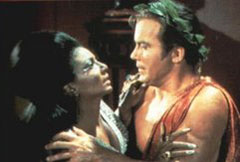Jim Crow Museum
1010 Campus Drive
Big Rapids, MI 49307
[email protected]
(231) 591-5873
Did the first interracial kiss occur on Star Trek?
-- Walter Sharpe, Cleveland, Ohio

The first kiss between an African American and a White American occurred long before the invention of the television. The first Black-White kiss on American network television is often credited to the Star Trek episode, "Plato's Stepchildren," which first aired on November 22, 1968.
In this episode, Captain Kirk of the Enterprise Starship, his first officer Mr. Spock, and chief medical officer, Dr. McCoy "beamed down" to a planet that had sent a distress call. When they arrived they encountered the Platonians, a human-like race of sadistic bullies who had the dress and mannerisms of Earth's ancient Greeks. All of the Platonians, except for Alexander, a dwarf who was kept as a jester and slave, had telekinetic powers. The distress call was sent because Parman, the Platonian leader, had an infection in his leg.
Dr. McCoy successfully treated Parman, but the Platonian leader demanded that the doctor remain on the planet. When Captain Kirk said that was unacceptable, the Platonians used their telekinetic powers to humiliate Captain Kirk and Mr.Spock. Dr. McCoy watched as his two friends were forced to sing, dance, and act like court jesters. The Platonians got bored and used their powers to bring other Enterprise officers to the planet for their entertainment, namely two females, Lieutenant Uhura, an African American, and Nurse Chapel, a European American.
The Platonians used their telekinetic powers to force Captain Kirk, played by William Shatner, a White actor, and Lieutenant Uhura, played by Nichelle Nichols, a Black actor, to kiss. National Broadcasting Company (NBC) executives, fearing that the kiss might anger Southern viewers, insisted that Shatner and Nichols turn their heads away from the cameras and pretend to kiss. Apparently, Shatner and Nichols disobeyed the NBC directive.
In 1968 there was still a strong taboo against interracial dating and interracial marrying. The previous year the United States Supreme Court had ruled that laws that forbade interracial marriage -- so-called anti-miscegenation laws -- were unconstitutional, but many Americans, primarily but not exclusively Whites, believed that interracial sexual unions, whether formalized with marriage rituals or not, were unnatural, unhealthy, and, maybe violated the will of God. So, a kiss, even a short one, on a popular television show between two well-known actors -- one a White man, the other a Black woman -- was a significant moment in American race relations.
Star Trek featured other interethnic or interracial kisses, but they did not involve African Americans. In the episode called "Space Seed," first aired February 16, 1967, Madlyn Rhue (Lieutenant Marla McGivers), a White woman, fell in love with and kissed Ricardo Montalban (Khan Noonien Singh), a dark Hispanic. On December 20, 1968, shortly after the Shatner-Nichols kiss, in an episode called "Elaan of Troyius," Shatner kissed France Nguyen Van-Nga, whose mother was French and father was Vietnamese. In neither of these episodes did the interracial kiss receive any significant notice. It is clear that the taboo against interracial kissing or intimacy was greatest when it involved Blacks and Whites.
Nichols' role as Lieutenant Uhura, communications officer for the Enterprise, is frequently seen as the first Black female television character that was not racially stereotyped, meaning, not a maid, housekeeper, or some other variant of the Mammy caricature. Cicely Tyson's character (Jane Foster, a secretary) in the 1963-64 series East Side/West Side was an earlier television role that did not racially stereotype a Black female actress. But Star Trek had a bigger audience and grew into an important part of American popular culture. NBC executives tried to keep her role small and she considered quitting Star Trek midway through its first season, when her character remained underdeveloped. In one interview, she described Uhura as "a glorified telephone operator in space."
When Nichols met Dr. Martin Luther King, Jr. at a civil rights meeting, Dr. King told her that he and his family were fans of Star Trek and admirers of her. When she told him that she was contemplating quitting the show he was disappointed, saying, "'You cannot! You absolutely must not. Do you know that you have the first non-stereotypical role on television? You're a first. This is not a female role. This is not a black role. This is a quality role, and this is an equal role, and it is in a command position. You have to carry on, because not only do little black children and do women see you and aspire and do you have meaning for them, but everyone else sees us for the first time the way we are supposed to be -- on an equal basis, and on a level of dignity and authority and with the highest of qualifications.'" (Quote found October 23, 2007, at http://www.trektoday.com/news/050901_05.shtml).
Nichols remained on the show, tilled the soil for many African American actors and actresses, and by kissing a White man on screen, made a significant strike against Jim Crow Era thinking.
Watch the Kirk and Uhura Kiss on You Tube
November 2007 response by
David Pilgrim
Curator
Jim Crow Museum